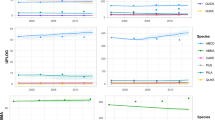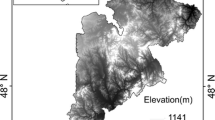Abstract
A succession model for mixed evergreen forests of the southern Cape, South Africa, called OUTENIQUA, was developed based on one for subtropical rain forest in New South Wales, Australia. The model simulates the regeneration, growth and mortality on a 0.04 ha plot using an individual-tree based modeling approach to forest succession. The OUTENIQUA model was tested on its ability to simulate species dynamics of the forest stand used for its development, as well as on independent data from a neighboring stand and not used for the model derivation. The model is used as a research tool to summarize published and unpublished knowledge on the southern Cape forests and to highlight aspects where knowledge is insufficient. The development of the model represents a test of an individual-tree gap model as a simulation tool for use in management and directing research in subtropical and tropical forests.
Similar content being viewed by others
References
Aubreville, A. 1933. La forêt de la Côte d'Ivoire. Bull. Comm. Afr. Occid. Franc. 15: 205–261.
Aubreville, A. 1938. La forêt colonial: Les forêts de l'Afrique occidentale française. Ann. Acad. Sci. Colon. Paris 9: 1–245.
Botkin, D.B., Janak, J.F. and Wallis, J.R. 1972. Some ecological consequences of a computer model of forest growth. J. Ecol. 60: 849–872.
Brown, W.H. and Mathews, D.M. 1914. Phillippine dipterocarp forests. Philipp. J. Sci. (Sect. A) 9: 413–561.
Dale, V.H. and Hemstrom, M. 1984. CLIMACS. A computer model of forest stand development for Western Oregon and Washington. U.S.D.A. Forest Service. Research Paper. PNW-327.
Dale, V.H., Doyle, T.W. and Shugart, H.H. 1985. A comparison of tree growth models. Ecol. Modell. 29: 145–169.
Dawson, J.W. 1962. The New Zealand lowland podocarp forest. Is it subtropical? Tuatara, Wellington 9: 98–116.
Donald, D.G.M. and Theron, J.M. 1983. Temperate evergreen broad-leaved forests of Africa south of the Sahara. In Temperate Broad-Leaved Evergreen Forests, pp. 135–168. Edited by J.D. Ovington. Elsevier, Amsterdam.
Finigan, B. 1984. Forest succession. Nature Vol. 312: 109–114.
Geldenhuys, C.J. 1975. Die autekologie van Podocarpus falcatus. M.Sc. Thesis, University of Stellenbosch (unpublished).
Geldenhuys, C.J. 1979. Voorlopige soortelys vir die Suid-Kaap woude. File 23/1/3-1/03/01/02/01, Forestry Branch, Dept. of Environment Affairs (unpublished).
Geldenhuys, C.J. 1982. The management of the southern Cape forests. S.A. Forestry Journal 121: 4–10.
Geldenhuys, C.J. 1987. Distribution and classification of the indigenous evergreen forest and deciduous woodland in South Africa. In Forestry Handbook, pp. 443–453. Edited by K. von Gadow, D.W. van der Zel, A. van Laar, A.P.G. Schonau, H.W. Kassier, P.W. Warkotsch, H.F. Vermaas, D.L. Owen and J.V. Jordaan. V & R Printers, Pretoria.
Horn, H.S. 1981. Some causes of variety in patterns of secondary succession. In Forest Succession: Concepts and Application, pp. 24–35. Edited by D.C. West, H.H. Shugart and D.B. Botkin. Springer-Verlag, New York.
Innis, G.S. 1976. Reductionist vs whole system approaches to ecosystem studies. In Ecological Theory and Ecosystem Models, pp. 31–36. Edited by S.A. Levin. Institute of Ecology, Indianapolis.
Kasanga, H. and Monsi, M. 1954. On the light-transmission of leaves, and its meaning for the production of matter in plant communities. Jap. J. Bot. 14: 304–312.
Ker, J.W. and Smith, J.H.G. 1955. Advantages of the parabolic expression of height-diameter relationships. For. Chron. 31: 235–246.
Kira, T. 1978. Community architecture and organic matter dynamics in tropical lowland rainforests of Southeast Asia with special reference to Pasoh Forest, West Malaysia. In Tropical Trees as Living Systems, pp. 561–590. Edited by O.B. Tomlinson and M.H. Zimmerman. Cambridge University Press, Cambridge.
Kramer, P.J. and Kozlowski, T.T. 1960. Physiology of trees. McGraw-Hill, New York.
Levins R.I. and Lewontin, R. 1982. Dialectics and reductionism in ecology. In Conceptual Issues in Ecology, pp. 107–138. Edited by E. Saarinen. Reidal, Utrecht.
Loomis, R.S., Williams, W.A. and Duncan, W.G. 1967. Community architecture and the productivity of terrestrial plant communities. In Harvesting the Sun. pp. 291–308. Edited by A. San Pietro, F.A. Greer and T.J. Army. Academic Press, New York.
Mankin, J.B., O'Neill, R.V., Shugart, H.H. and Rust, B.W. 1977. The importance of validation in ecosystem analysis. In New Directions in the Analysis of Ecological Systems. Part i. pp. 63–71. Edited by G.S. Innis. Simulation Councils of America, LaJolla, California.
Moll, E.J. and White, F. 1978. The Indian Ocean coastal belt. In Biogeography and Ecology of Southern Africa, pp. 561–598. Edited by M.J.A. Werger. Dr W. Junk Publishers, The Hague.
Mueller-Dombois, D. and Ellenberg, H. 1974. Aims and methods of vegetation ecology. J. Wiley & Sons, New York.
Munro, D.D. 1974. Forest growth models. A prognosis. In Growth Models for Stand and Tree Simulation, pp. 7–21. Edited by J. Fries. Department of Forest Yield Research, Royal College of Forestry, Stockholm. Res. Notes 30.
Nicholson, D.I. 1965. A study of virgin forest near Sandakan, North Borneo. In Proc. Symp. on Ecological Research into Humid Tropics Vegetation. Kuching: UNESCO.
Oldeman, R.A.A. 1978. Architecture and energy exchange of dicotyledonous trees in the forest. In Tropical Trees as Living Systems, pp. 535–560. Edited by P.B. Tomlinson and M.H. Zimmermann. Cambridge University Press, Cambridge.
Perry, T.O., Sellers, H.E. and Blanchard, C.O. 1969. Estimation of photosynthetically active radiation under a forest canopy with chlorophyll extracts and from basal area measurements. Ecology 50: 39–44.
Phillips, J.F.V. 1931. Forest-succession and ecology in the Knysna region. Botanical Survey of South Africa, Memoire No. 14. Government Printer, Pretoria.
Robbins, R.G. 1962. The podocarp-broadleaf forests of New Zealand. Trans. Roy. N.Z. 1: 33–75.
Shugart, H.H. 1984. A theory of forest dynamics: Ecological implications of forest succession models. Springer-Verlag, New York.
Shugart, H.H., Hopkins, M.S., Burgess, I.P. and Mortlock, A.T. 1980.The development of a succession model for sub- tropical rain forest and its application to assess the effects of timber harvest at Wiangaree State Forest, New South Wales. J. Environ. Manage. 11: 243–265.
Shugart, H.H. and West, D.C. 1977. Development of an Appalachian deciduous forest succession model and its application to assessment of the impact of the chestnut blight. J. Environ. Manage. 5: 161–179.
Shugart, H.H. and West, D.C. 1980. Forest succession models. BioScience 30: 308–313.
Shugart, H.H. and West, D.C. 1981. Long-term dynamics of forest ecosystems. Am. Sci. 69: 647–652.
Shugart, H.H., West, D.C. and Emanuel, W.R. 1981. Patterns and dynamics of forests: An application of simulation models. In Forest Succession: Concepts and Application, pp. 74–94. Edited by D.C. West, H.H. Shugart and D.B. Botkin. Springer-Verlag, New York.
Van Daalen, J.C. 1984. Distinguishing features of forest species in nutrient-poor soils in the southern Cape. Bothalia 15(1&2): 229–239.
Watson, J.G. 1977. Age-class representation in virgin forest. Malay For. 9: 146–147.
Webb, L.J. 1959. A physiognomic classification of Australian rainforests. J. Ecol. 47: 551–602.
Webb, L.J., Tracey, J.G. and Williams, W.T. 1972. Regeneration and pattern in the subtropical rainforest.J. Ecol. 60: 675–695.
White, F. 1978. The Afromontane region. In Biogeography and Ecology of Southern Africa, pp. 463–513. Edited by M.J.A. Werger. Dr W. Junk Publishers, The Hague.
Whitmore, T.C. 1975. Tropical rain forests of the far east. Clarendon Press, Oxford.
Author information
Authors and Affiliations
Rights and permissions
About this article
Cite this article
van Daalen, J.C., Shugart, H.H. OUTENIQUA — A computer model to simulate succession in the mixed evergreen forests of the southern Cape, South Africa. Landscape Ecol 2, 255–267 (1989). https://doi.org/10.1007/BF00125095
Issue Date:
DOI: https://doi.org/10.1007/BF00125095




